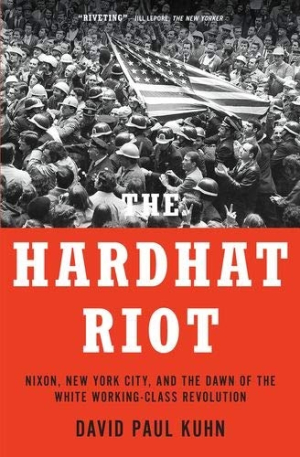The Hardhat Riot
Nixon, New York City, and the Dawn of the White Working-Class Revolution
The Hardhat Riot moves, moment by tense moment, through May 8, 1970, a day known as Bloody Friday, which led to the fracturing of the Democratic Party and an opportunity for Richard Nixon.
Starting with a glimpse of the fateful hour when tensions exploded, David Paul Kuhn’s The Hardhat Riot doubles back to reveal the simmering tensions that created a perfect storm of conflicting ideologies between anti-war protestors and the working class. There were already issues of animosity toward, and jealousy of, white student protestors who were children of privilege. There was also a feeling of dissatisfaction with political representation that had been brewing within the white working class.
In the early hours of May 8th, anti-war protestors gathered on Wall Street. Seventy-five police officers were assigned to the rally in anticipation of possible clashes, but no one predicted how bad it would get. Onlookers would later express surprise at the lackluster response of the police when construction workers confronted protestors and became physical. Yet, Kuhn says, what many failed to dissect was that police shared the sentiments of the workers; they’d felt verbally abused in interactions with the college-aged protestors. The startling realization that the Democratic Party was at war with itself began.
Kuhn makes use of masterful, disturbing imagery to capture the clash, including of the stoic reactions of some in the face of the violence. His narration is candid, revealing anew the decades-old occurrence with never-before-publicized statements from those in power. The perspectives of both sides are shared without favoritism—only the facts. The text is fascinating as it traces the political breakdown that became the platform upon which Nixon built a new base.
Hardhat Riot is a timely review of a historical event that contains a reminder that class divisions also create opportunities within politics.
Reviewed by
Tanisha Rule
Disclosure: This article is not an endorsement, but a review. The publisher of this book provided free copies of the book to have their book reviewed by a professional reviewer. No fee was paid by the publisher for this review. Foreword Reviews only recommends books that we love. Foreword Magazine, Inc. is disclosing this in accordance with the Federal Trade Commission’s 16 CFR, Part 255.

